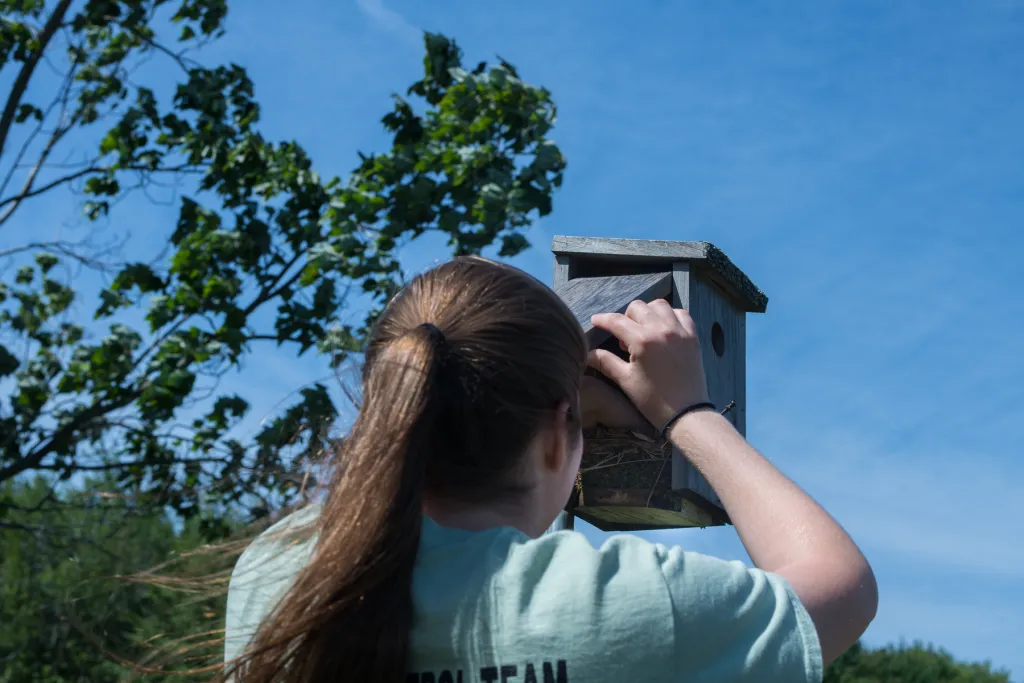
mosquito control project
Our Biddeford Campus, located in beautiful coastal Maine on 560 acres, is situated at the mouth of the Saco River where it flows into the Atlantic Ocean. Habitats including forested vernal pools, marshes, and wetlands create ideal locations for mosquitoes and their resulting mosquito-borne viruses. The goals of the University’s Integrated Pest Management (IPM) Program include maintaining a safe and sustainable campus environment and protecting human health by suppressing pests that threaten public health and safety. A natural predator approach is a logical solution.
The mosquito control project, originating from a collaborative effort between the Environmental Health and Safety Department and the Department of Environmental Studies, has been the backbone of the biological control approach to reducing mosquito populations at the Biddeford Campus. This component of the IPM program involves creating a habitat for mosquito-eating birds and bats and increasing the presence of mosquito-repellent plants. The two departments collaborate to oversee the education and work of student interns who manage the program each summer.
Birds
There are 20–35 birdhouses in any given year on UNE’s Biddeford Campus — these boxes were designed to host nesting native Eastern Bluebirds and Tree Swallows. Mosquitoes are one of their food sources, providing a natural way to reduce mosquito populations. Each summer a student intern closely monitors each birdhouse, checking for nests, eggs, and young. The students get to know each clutch of baby birds personally as they hatch and are weighed and leg-banded for record-keeping purposes. We also band adult birds that return to their nesting places to mate and raise their clutch of eggs each year. We collect fecal samples from the adults and chicks and use molecular techniques to identify what species of mosquitos the adults eat and feed their chicks if they eat different species in different times of the summer, and if Bluebirds and Tree Swallows differ in their use of mosquitos as food.
IPM Plants
Naturally mosquito repellent plants are favored alternatives to synthetic mosquito repellant chemicals. An important component of the mosquito control project on the Biddeford Campus is the strategic placement of potted plants at the entrances of most buildings. The large pots contain several different mosquito repellent plants including lavender, basil, rosemary, marigolds, and — most importantly — Citrosa, or scented geraniums. The key to activating the fragrances that keep mosquitos away is to physically brush and rub the leaves of all these plants. Our Grounds Department discovered a clever way to encourage this behavior is to plant more edibles, including cherry tomatoes, in the pots. When people pass the pots and reach in to pick a tomato or herb, they inadvertently brush the leaves of the mosquito repellent plants, releasing the beneficial fragrances.
Bats
Providing homes for the eight different bat species in Maine is more crucial than ever. White Nose Syndrome — Geomyces destructans — caused the bat population to decline by 90% in hibernacula across New England. White Nose Syndrome causes the bats to wake from their winter hibernation prematurely and use the fat reserves they have stored to make it through the winter. Bats eat various bugs, such as night-flying insects, flies, mosquitos, moths, and beetles. A little Brown Bat can eat up to 1,000 mosquitos an hour. Several bat boxes have been placed on campus to provide much-needed habitat, but to date, few have used them in the summer months.
